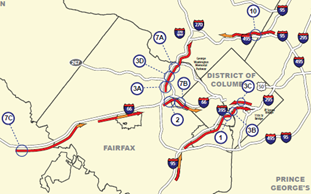Integrating CMP Components
Considering Information on Existence and Extent of Congestion
The travel monitoring activities associated with the CMP inform decision makers on the region's congestion. Planning and programming decisions are able to be made with knowledge of the region's significant congestion issues.
|

|
Example from the 2014 freeway aerial photography survey results
|
The regional Congestion Monitoring Program is key to providing this information. Periodic congestion data on all 340 miles of freeway in the region shows the locations of significant congestion, as shown in the right figure. These are then able to be cross-compared with other pertinent information. Information for the region's numerous non-freeway arterial highways is provided by the I-95 Corridor Coalition Vehicle Probe Project and the results were then reported in the CMP Technical Report.
The region considers congested locations with a number of other types of information, such as:
- Facility, corridor, or area studies: Studies help agencies determine problems, solutions, costs, and related information to addressing transportation issues. The CLRP contains information on ongoing or proposed studies for facilities and corridors. Similar to the planned and programmed projects in the CLRP and TIP, the locations of studies is recommended to be cross-compared to the locations of congestion as noted from the CMP.
- Regional Activity Centers and land use considerations: Regional Activity Centers and clusters are identified throughout the region as locations experiencing a concentration of employment, housing, and activity. Movement to and from these Activity Centers, in addition to within them, is considered in the CMP. Activity Centers that have a mix of uses where people can live and work, along with having accessibility to other activity centers, is an important consideration in congestion management. In addition, because activity centers are often thought of to be pedestrian-oriented facilities and/or a higher density of development, safety issues are also concerns of the CMP.
This is also linked to Growth Management, an aim at ensuring that residents have access to a variety of transportation modes as this region grows.
- Transportation safety information is important to incident management and non-recurring congestion. Safety in itself is a primary concern in our region. However, congestion can often result from incidents and secondary incidents on our roadways. A focus of the CMP is integrating and assessing incident management, ITS technologies, and other operational management strategies that can help prevent and clear incidents safely and efficiently.
Considering CMP Strategies
The region compiles information on the congestion management strategies considered, implemented, or committed to in conjunction with roadway projects or studies. This provides an overall picture of congestion in the region, and helps set the stage for agencies to implement CMP strategies, including those integrated into capacity-increasing roadway projects.
Considering the Impacts of Implemented CMP Strategies
Each strategy is assessed in the post-implementation phase. This determines the success each strategy has at reducing congestion. Considering the impacts and results becomes especially important when updating the CMP and considering adding new strategies to the process.
Considering CMP Components of Major Projects
For planned (CLRP) or programmed (TIP) projects, the locations of planned or programmed improvements on freeways are able to be noted with the locations of congestion. The level of correlation is shown between projects and congestion. This helps guide decision makers as to prioritize areas for current and future projects.
For the CLRP, the correlation between congested locations as shown in the CMP and planned or programmed projects was high. Most planned or programmed projects were in locations where significant congestion is being experienced.
Future Outlook for Maintaining and Enhancing the CMP
The CMP is to be a living document, and an ongoing and developing process. Congestion information will be updated as it becomes available. The process itself will be updated as is determined to be necessary. Addressing congestion and meeting regional goals is an integral part of the TPB's metropolitan planning process. As the Washington region continues to grow, congestion management will remain a primary goal of the TPB.